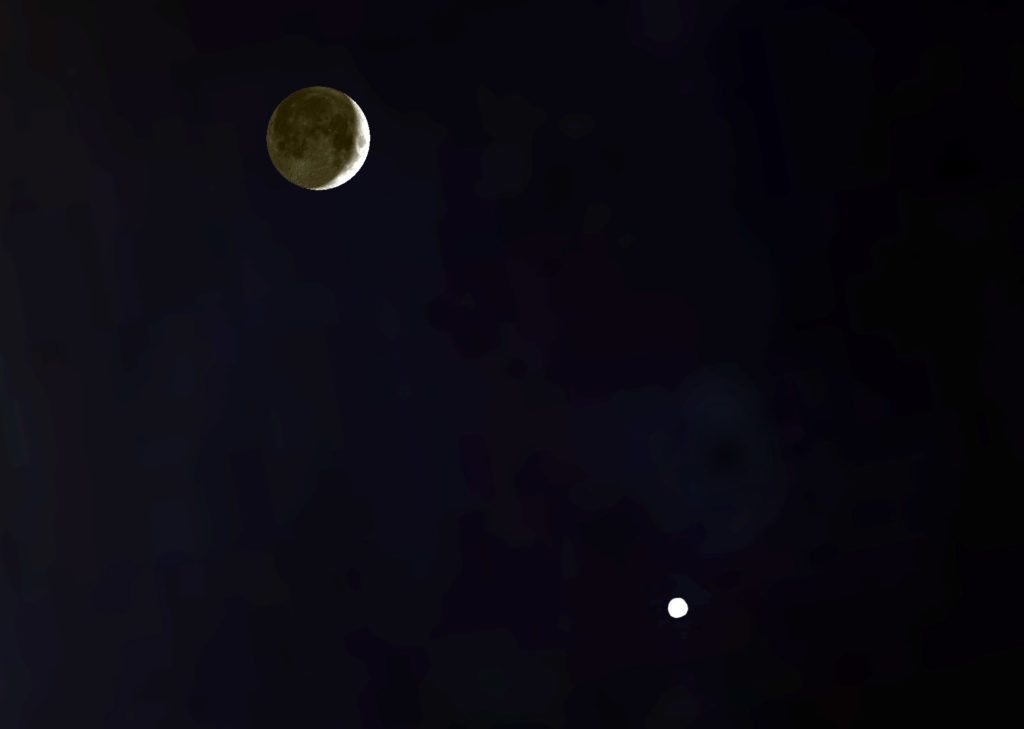Sky Report: October 4 – October 10

Venus is 6 moon-diameters from the crescent moon on the 9th. Graphic created with SkySafariAstronomy.com.
Three bright planets are out tonight and two of them are brighter than any star, so it’s a good time to be planet-watching.
Brightest and first to appear is Venus, poetically called the “Evening Star”. Venus is a quarter of the way up the southwestern sky at the moment of sunset, and you can spot it soon after, especially if you have binoculars (I recommend 7×50). Venus sets two hours after the sun.
Don’t miss the conjunction of the crescent moon and Venus on the night of Saturday the 9th. Then the moon will be 3° – not quite the width of two fingers held at arm’s length – to the upper left of Venus. That’s close enough to see both at once in binoculars. There’s a surprising amount to notice. First, they appear close – and that happens without fail once a month as the moon passes Venus as it orbits the earth – but in reality Venus is 340 times more distant. The moon appears bigger, but in reality Venus is the size of the earth and the moon has ¼ our planet’s diameter. But notice how brilliantly Venus shines; it’s a fraction the apparent size of the moon but is 1/16 as bright. That’s because Venus is shrouded with permanent clouds that reflect 70% of the sunlight that falls on them whereas the moon is covered with rocks that are as dark as asphalt and that reflect only 12% of the sunlight that hits them, and that’s a huge difference.
A final thing to notice is that the crescent moon is lit by light reflected from earth – earthlight – and you can see features on the dark part of the moon, especially with binoculars (which every skywatcher must have). If you were on the moon, you’d see the earth go through phases, just as the moon does to us, but they’re reversed; when the moon is full, from the moon the earth is new. So when the moon is a crescent, like now, the earth is bright in the lunar sky, and being bigger and more reflective (30%) the nearly full earth really lights up the lunar landscape. The faint part of the moon is poetically called “the old moon in the young moon’s arms”.
The faint stars in the background are in the claws of Scorpius.
Far to the left are Jupiter and Saturn. Jupiter is the third brightest object in the night sky, after the moon and Venus, so you can’t miss it, and Saturn is 15° to the upper right of Jupiter.
The moon leaves Venus and is near Saturn on the 10th and roughly between Jupiter and Saturn on the 11th.
Mars is behind the sun. On the 8th they’re in conjunction, but of course you can’t see it. Mars emerges from the glare of the sun in the dawn sky in late November, and the best time to see it comes in December 2022 when it’s opposite the sun and closest to earth (and brightest).
Under a grant from the Utah Governor’s Office of Economic Development and the Kane County Office of Tourism, Stellar Vista Observatory offers portable telescopes and tripod mounted binocular kits on loan for free to all residents of Kane County. Nothing beats a quality binocular or astronomical telescope to enhance enjoyment of the night sky! Visit https://stellarvistaobservatory.org/discover-the-night-sky/ or Kanab City Library for full details.
The Sky Report is presented as a public service by the Stellar Vista Observatory, a nonprofit organization based in Kanab, Utah, which provides opportunities for people to observe, appreciate, and comprehend our starry night sky. Additional information is at www.stellarvistaobservatory.org. Send questions and comments to John@StargazingAdventures.org.






Comments are closed.